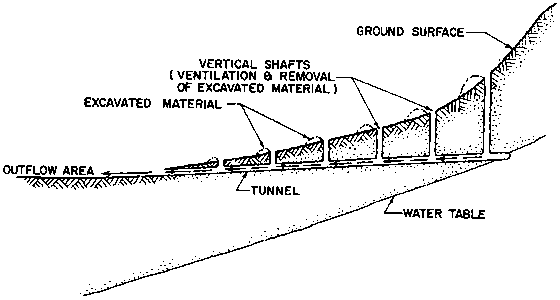The infiltration gallery is a horizontal chamber constructed below the water table. It is used where large inflow area is needed due to low permeability. It is constructed by excavating a large trench. This trench is lined with gravel and a row of precast concrete cylinders is laid along the axis of the trench to form the gallery. Joints are left open enough to permit the entry of water. The gravel pack is completed around the gallery and the trench is backfilled. Provision is made to pump water from the gallery. Where it is desired to purify unclean or silt-laden stream or river water an infiltration gallery can be constructed parallel to and a short distance from the stream.
Ghanats (also Kanats, Quanats, etc) are slightly inclined tunnels the upper end of which intersects the water table usually in alluvial material at the base of a mountain or foothill. Water flows along the floor of the tunnel until it intersects the ground surface at some location of lower elevation. Vertical shafts extend from the ceiling of the tunnel to the ground surface. These serve the dual purpose during construction of providing ventilation and as an exit for the excavated material. Ghanats have been constructed in the Middle East for the past 2 500 years. They may be several kilometres long and have been used both for irrigation and municipal water supply. Many are still in use in certain regions of Iran.
Fig. 56 Ghanat
